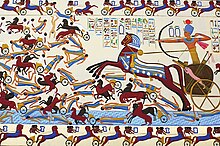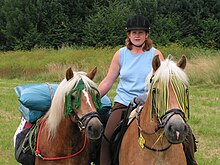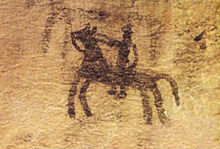horse riding

Riding refers to the movement of humans on the back of an animal . These can be horses , but also other mounts such as donkeys or camels .
Horses as mounts
history
Horses played an important role in human history, in traffic , trade and agriculture worldwide .
The horse was probably born around 3000 BC. Chr. In Central Asia domesticated . Perhaps horses were domesticated in several places independently of one another. The earliest evidence of domesticated horses is around 5000 years old and can be found in the Botai culture . Traces of wear and tear from bones and hair bits were found. Pens with horse manure and around 5600 year old potsherds with remains of kumys (fermented mare's milk).
The early empires of the Assyrians and Hittites and the Hurrians in Mitanni -State benefited from the utilization of the horse in war. Horses were used both as riding and draft animals (e.g. from chariots ). A manual for training horses is from Kikkuli .


In the period from 1650 to 1550 BC During the conquest of Lower Egypt , the Hyksos brought horses to Egypt as farm animals. They pulled chariots.
Equestrian nomad peoples such as the Scythians settled from around the 8th/7. Century BC The Eurasian steppes north of the Black Sea .
In ancient Greece the art of horsemanship flourished. Xenophon's (approx. 430-354 BC) works by Hipparchikos and Über die Reitkunst are today often seen as the basis of hippology . Its principles remain unchanged today.
Beginning in antiquity through to modern times , the military arm of the cavalry was considered to be dominant because it was much faster and more agile than the foot troops . The art of riding made it possible for the rider to use the pack animal as a weapon (as in the case of the horse using the caper as a liberation blow). The cavalry also shaped modern equestrian sport, which emerged from their teaching methods. Originally used as a quick way to travel, riding in industrialized countries is mainly used in equestrian sports , leisure activities and therapeutic riding . The trail riding is often led on bridle paths. There are also widespread cavalry units of the police and cavalry units of the army for representation, for example in Great Britain and France.
Impact
The rider can act on the mount in various ways. The effects are called aids . These include weight shift, thigh pressure, reins or leashes, and the voice . Aids such as whips and spurs are also used. The interplay of the aids for communication with the animal is decisive; isolated help is not very effective.
Well-trained, sensitive animals respond to minimal help that is barely noticeable from the outside. The “ Kluge Hans ”, a “calculating” horse, recognized from the tension and relief of the questioner how often he should tap his hoof.
equipment
Different types of saddles are placed on the mounts in order to give the rider the most comfortable and secure seat possible and to distribute the weight of the rider as evenly as possible on the back of the mount. There are different types of saddles depending on the intended use. A jumping saddle enables shorter stirrups, which is necessary for show jumping. Similar to the racing saddle, which allows the jockey (racing rider) to reach the greatest speed by leaning forward. A dressage saddle allows a long, deep seat. The western saddle enables the rider to sit comfortably for a long time.
In addition, a bridle or a choker is usually used and to be able to act on the neck and head of the mount.
Furthermore, there are very different accessories in each division of the cavalry. Accessories to protect the legs, such as bell boots , gaiters or bandages to support tendons, joints and ligaments can be found in almost all branches .
So-called auxiliary reins can also be found regularly. There are a number of different auxiliary reins with different effects. All auxiliary reins should help the rider to ride the horse in accordance with what is part of the classic horse training scale.
Riding styles
German equestrian facilities mainly offer training as a dressage , show jumping and eventing rider (combination of dressage, cross-country riding and a jumping course). But you can also take part in rides for leisure . The associated riding style is often called the "English riding style". The sporting association as a member of the German Olympic Committee is the German Equestrian Association .
Western riding is widespread in America, which is part of the “Ersten Westernreiter Union Deutschland e. V. “(EMU) is organized.
The riding styles differ in the equipping of the horses and the provision of aids, but each has the goal of dealing with the horse as a partner in such a way that the animal can be used without any health impairments over the usual period of use up to around the age of 20.
Horses have three basic gaits: walk , trot and gallop . In some breeds there are also other gaits , such as pass or tölt, with which long distances can be covered comfortably. When trotting and galloping, a horse has a "floating phase", that is, it does not touch the ground with any leg.
More mounts
In addition to various horse breeds , donkeys , mules , mules , camels ( dromedaries , trample ) and elephants are used as riding animals . Camels move in the pace , the legs are not moved diagonally as in a trot, but in pairs to the right and left.
Other animal species are also used less frequently as mounts. Reindeer and elk are also ridden in northern regions , for example among the Evenks .
Cattle, such as water buffalo and yaks , can also be ridden. Bull riding , on the other hand, is just a rodeo competition.
Ostriches have recently been used as mounts for tourist attractions. The same goes for llamas , which can be ridden by children.
See also
- Hippology
- Riding arena fabric , is used in the construction of riding arenas
- Riding saddle
- Riding law
literature
- Burchard Brentjes : Man's oldest riding animal. Berlin 1960.
Web links
Individual evidence
- ↑ Thomas Jansen et al: Mitochondrial DNA and the origins of the domestic horse. In: PNAS . Volume 99, No. 16, 2002, pp. 10905-10910. doi: 10.1073 / pnas.152330099 ( full text ; PDF)
- ↑ Vera Warmuth et al: Reconstructing the origin and spread of horse domestication in the Eurasian steppe. In: PNAS. Online advance publication of May 7, 2012, doi: 10.1073 / pnas.1111122109
- ↑ Alan K. Outram, NA Stear, R. Bendrey, S. Olsen, A. Kasparov, V. Zaibert, N. Thorpe, R. Evershed: The Earliest Horse Harnessing and Milking. In: Science. Volume 323, 2009, pp. 1332-1335.
- ^ Hélène Martin, Dominique Armand: The horse: Domestication. In: Steppe Warriors. Riding nomads of the 7th – 14th centuries Century from Mongolia. Primus Verlag, LVR-Landesmuseum Bonn, 2012, p. 88 f. Excerpt: "The sites suggested as the cradle of horse keeping are in areas such as Ukraine and Kazakhstan and are between 5000 and 6000 years old. An example is the settlement of Botai in Kazakhstan, which dates back to around 3700-3100 BC . is dated and in which the oldest evidence for the domestication of the horse was found. "
- ↑ Прорыв в прошлое
- ↑ * Kurt Sethe : New traces of the Hyksos in inscriptions of the 18th dynasty . In: Georg Steindorff (Hrsg.): Journal for Egyptian language and antiquity . Forty-seventh volume. Hinrichs'sche Buchhandlung, Leipzig 1910, p. 73–86 ( digitized version [accessed April 12, 2016]).
- ↑ The most important thing here is a species-appropriate attitude and the avoidance of excessive demands in sports ( Memento of the original from May 14, 2011 in the Internet Archive ) Info: The archive link was inserted automatically and has not yet been checked. Please check the original and archive link according to the instructions and then remove this notice.
- ↑ Oil and gas abundance endangers indigenous people and unique nature.
- ↑ Marajo - the island of the buffalo. Carsten Upadek, WDR, December 22, 2016.
- ↑ The yak as a pack animal and mount. Yakranch ( page no longer available , search in web archives ) Info: The link was automatically marked as defective. Please check the link according to the instructions and then remove this notice.
- ↑ Lamatrekking





